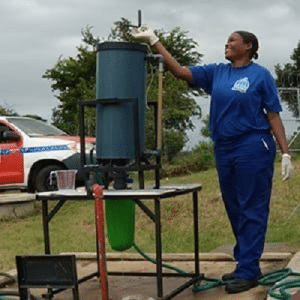
Agriculture
August 15, 2024
Struvite Reactor Tank
Read SolutionImplemented by
EAWAG
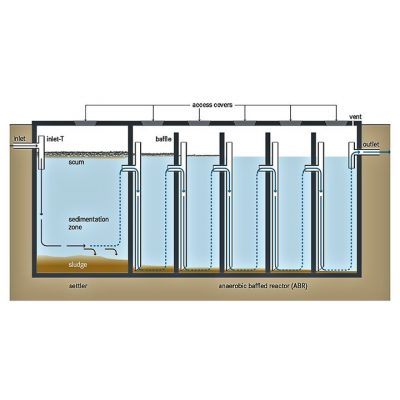
Updated on August 16, 2024
·Created on September 1, 2021
An Anaerobic Baffled Reactor (ABR) is an upgraded version of a septic tank and consists of a series of baffles designed to treat wastewater.
Anaerobic baffled reactors (ABR) are a sanitation technology designed to treat wastewater and fecal sludge through both physical and biological treatments. ABRs are improved versions of septic tanks where the addition of baffles in series increases contact time of wastewater and active biomass (sludge), which results in improved treatment. The process starts with settling. Before reaching the ABR, the wastewater passes through a settling tank, which removes most of the solid particles that can settle at the bottom. The biological treatment involves anaerobic digestion, which works better in warmer conditions. As the wastewater moves through the baffles, the alternating up-and-down flows increase the time the wastewater spends with the sludge, which contains microorganisms that break down the organic pollutants without oxygen.
ABRs are relatively simple to operate and are resistant to hydraulic and organic shock loads, require no energy, have low operating costs, result in high reduction of BOD, and produce low amounts of sludge. The wastewater effluent and sludge from the ABR still require additional treatment. Therefore, ABRs are best used in combination with other treatment technologies and can be incorporated into decentralized wastewater treatment systems (DEWATS).
The price will depend on costs for local labor, local materials, and expert design.
The technology is open-source, with comprehensive design instructions for installation available through the following resources:
Target SDGs
SDG 6: Clean Water and Sanitation
Target Users (Target Impact Group)
Household, Community
Distributors / Implementing Organizations
Numerous organizations work on designing and implementing ABRs, some of which include: the Sustainable Sanitation and Water Management (SSWM), seecon, Bremen Overseas Research and Development Association (BORDA), and the Environment and Public Health Organization (ENPHO).
Competitive Landscape
Direct competitors include NG-SEPCLEAN (Next Generation Septic Tank), Johkasou, Decentralized Wastewater Treatment Systems (DEWATS), and The Biofil Digester.
Regions
Worldwide
Manufacturing/Building Method
This product is manufactured globally, typically using locally available resources and labor.
Intellectural Property Type
Open-source
User Provision Model
Requires expertise in design and construction, but local technicians, NGOs, and governments have assisted in implementing ABRs.
Distributions to Date Status
Unknown
Flow rate (L/min)
1.4 – 140 L/min
Power Supply Type
No power needed
Technology type
Sedimentation, Anaerobic treatment
BOD Removal Efficiency
70% to 95%
COD removal efficiency
65% to 90%
NH4-N Removal Efficiency
Can cause increase when ABR only, but when combined with additional or hybrid treatments can result in 36-44% removal
TSS removal efficiency
90%
Total Phosphorus Removal Efficiency
Can cause increase when ABR only, but when combined with additional or hybrid treatments can result in 17-26% removal
Fecal Coliform Removal Efficiency
68%
Design Specifications
Possible influents: blackwater, greywater, brownwater, and fecal sludge
Byproducts: biogas in addition to biosolids and effluent which require additional treatment for pathogen removal.
Typical inflows: 2 - 200 m3/day.
Hydraulic retention time (HRT): 48 - 72 hours
Upflow velocity: less than 0.6 m/hr (not to exceed 2 m/hr)
Organic load should be below 3 kg COD/m3/day
Number of chambers: at least 1 sedimentation chamber & between 2 to 5 upflow chambers.
Chamber sizes: less than 75 cm in length and less than 60% of the total height. In order to keep upflow velocities slower, the tanks should be kept shallow but can be made wider to adapt for larger loads.
Vertical pipes or baffles can be used to connect chambers.
Access ports are located on top of each chamber for maintenance. Venting is required to release the buildup of gases formed as a byproduct of anaerobic digestion. Although not typically collected, biogas can be collected and used to power certain power needs like operating pumps or cooking.
No electricity required.
Treatment process: The process should start with a settling chamber for removal of larger solids. Wastewater flows upward through the tanks, starting at the bottom where the wastewater is forced to pass through the sludge and interact with the activated biomass. As the wastewater travels through the baffles, the alternating upward and downward flows increases contact time between the wastewater and the residual sludge, which contains the microorganisms that anaerobically digest organic pollutants. The separate compartments allow for the HRT and SRT to be decoupled, enabling the wastewater to be treated on shorter time scales (hours).
Start-up period for the ABR can be long due to slow growth of the anaerobic biomass. This start-up period can be shortened by inoculating the ABR with anaerobic bacteria from fresh animal dung. Use of the ABR should be incrementally increased over months to allow for new growth of anaerobic biomass.
Technical Support
Support provided by implementer or user.
Replacement Components
Unknown
Lifecycle
Generally long lasting, but depends on ABR size, number of chambers, and frequency of sludge removal.
Manufacturer Specified Performance Parameters
ABRs are designed to treat wastewaters, achieving up to 90% removal of BOD and TSS, and sludge, producing low amounts that are stabilized. ABRs have low operating costs, require no energy inputs, and are simple to operate.
Vetted Performance Status
Applicability of ABRs as solutions for handling blackwater treatment system with infiltration or effluent transport was discussed in Eawag’s Compendium of Sanitation Systems and Technologies (2nd Revised Edition). The appropriateness of anaerobic baffled reactors (ABRs) for on-site primary sanitation in low-income communities was evaluated using a pilot project testing COD removal in domestic wastewater. Results indicate that COD removal was sufficient for agricultural reuse but insufficient for discharging into surface or groundwater. The following study reports on the effectiveness of ABRs in removing organic pollutants.
Safety
Effluent and sludge must be handled with care since pathogens and nutrients are not removed. Effluent and sludge requires additional treatment.
Complementary Technical Systems
Requires water for flushing. Sludge and scum require regular removal (every 1 to 3 years). Sludge and scum removal strategy and technology including: road access for vacuum trucks (e.g. a Motorized Emptying and Transport technology) or a Human-powered Emptying and Transport Technology.
Academic Research and References
Tilley, E., Ulrich, L., Lüthi, C., Reymond, P., & Zurbrügg, C., 2014, Compendium of Sanitation Systems and Technologies (2nd Revised Edition), Swiss Federal Institute of Aquatic Science and Technology (Eawag), Duebendorf, Switzerland.
Khalekuzzaman, Md. et al., 2018, Performance comparison of uninsulated and insulated hybrid anaerobic baffled reactor (HABR) operating at warm temperature, Water Science & Technology 78(9): 1879-1892.
Foxon, K. M., Pillay, S., Lalbahadur, T., Rodda, N., Holder, F., & Buckley, C. A., 2004, The anaerobic baffled reactor (ABR): An appropriate technology for on-site sanitation, Water SA 30(5): 44–50.
Sasse, L., 1998, DEWATS: Decentralised Wastewater Treatment in Developing Countries, Bremen Overseas Research and Development Association (BORDA), Germany.
Morel, A. and Diener, S., 2006, Greywater Management in Low and Middle-Income Countries: Review of different treatment systems for households or neighbourhoods, Sandec (Water and Sanitation in Developing Countries) at Eawag (Swiss Federal Institute of Aquatic Science and Technology), Dübendorf, Switzerland.
Singh, S., Haberl, R., Moog, O., Shrestha, R. R., Shrestha, P., & Shrestha, R, 2009, Performance of an anaerobic baffled reactor and hybrid constructed wetland treating high-strength wastewater in Nepal—A model for DEWATS, Ecological Engineering 35(5): 654–660.
Bachmann, A. ; Beard, V. L. ; McCarty, P. L., 1985, Performance Characteristics of the Anaerobic Baffled Reactor, Water Research 19(1): 99-106.
Barber, W.P. ; Stuckey D.C., 1999, The use of the anaerobic baffled reactor (ABR) for wastewater treatment: A review, Water Research 33(7): 1559-1578.
BORDA, 2009, EmSan—Emergency Sanitation—An innovative & rapidly applicable solution to safeguard hygiene and health in emergency situations, Bremen Overseas Research and Development Association (BORDA) & BORDA BNS Network.
Stuckey, D. C., 2010, Anaerobic Baffled Reactor (ABR) for Wastewater Treatment, Environmental Anaerobic Technology, 163-184.
Compliance with regulations
Depends on national regulations. Can sometimes meet standards for agricultural application, but not surface water or groundwater discharge.
Evaluation methods
ABRs are primarily evaluated for removal and digestion of organic matter.

Agriculture
August 15, 2024
Implemented by
EAWAG
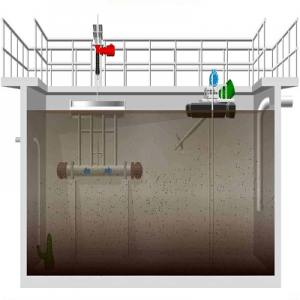
Agriculture
January 11, 2024
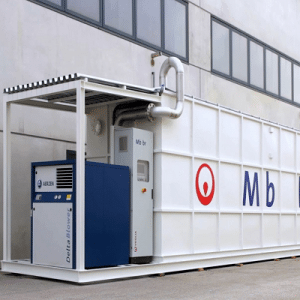
Agriculture
August 15, 2024
Implemented by
AnoxKaldnes
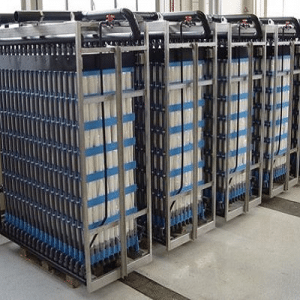
Agriculture
January 12, 2024
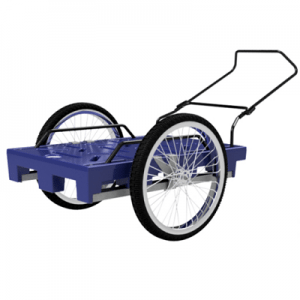
Agriculture
June 23, 2024
Implemented by
LoooP Creative Ltd
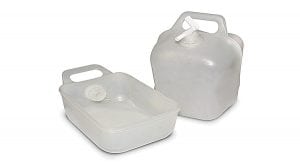
Agriculture
January 10, 2024
Implemented by
NRSRelief

Agriculture
January 22, 2024
Implemented by
Sanivation

Agriculture
December 13, 2023
Implemented by
change: Water
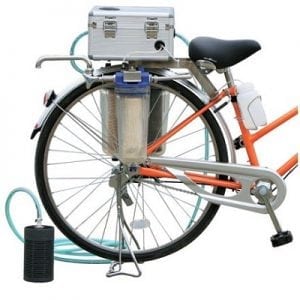
Agriculture
December 27, 2023
Implemented by
Nippon Basic Co. Ltd.
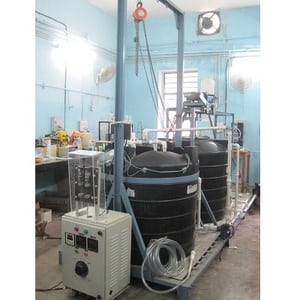
Agriculture
January 8, 2024
Implemented by
Gadgil Lab, University of California Berkeley
Have thoughts on how we can improve?
Give Us Feedback